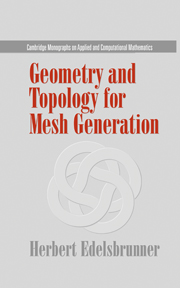2 - Triangle meshes
Published online by Cambridge University Press: 03 October 2009
Summary
The three sections in this chapter apply what we learned in Chapter 1 to the construction of triangle meshes in the plane. In mesh generation, the vertices are no longer part of the input but have to be placed by the algorithm itself. A typical instance of the meshing problem is given as a region, and the algorithm is expected to decompose that region into cells or elements. This chapter focuses on constructing meshes with triangle elements, and it pays attention to quality criteria, such as angle size and length variation. Section 2.1 shows how Delaunay triangulations can be adapted to constraints given as line segments that are required to be part of the mesh. Section 2.2 and 2.3 describe and analyze the Delaunay refinement method that adds new vertices at circumcenters of already existing Delaunay triangles.
Constrained triangulations
This section studies triangulations in the plane constrained by edges specified as part of the input. We show that there is a unique constrained triangulation that is closest, in some sense, to the (unconstrained) Delaunay triangulation.
Constraining line segments
The preceding sections constructed triangulations for a given set of points. The input now consists of a finite set of points, S ⊆ ℝ2, together with a finite set of line segments, L, each connecting two points in S. We require that any two line segments are either disjoint or meet at most in a common endpoint.
- Type
- Chapter
- Information
- Geometry and Topology for Mesh Generation , pp. 26 - 43Publisher: Cambridge University PressPrint publication year: 2001



